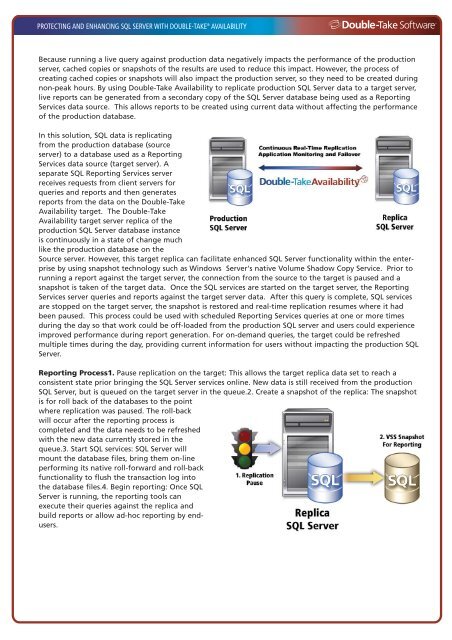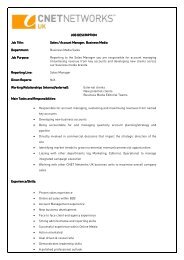Protecting and Enhancing SQL Server with Double-Take Availability
Protecting and Enhancing SQL Server with Double-Take Availability
Protecting and Enhancing SQL Server with Double-Take Availability
Create successful ePaper yourself
Turn your PDF publications into a flip-book with our unique Google optimized e-Paper software.
PROTECTING AND ENHANCING <strong>SQL</strong> SERVER WITH DOUBLE-TAKE ® AVAILABILITYBecause running a live query against production data negatively impacts the performance of the productionserver, cached copies or snapshots of the results are used to reduce this impact. However, the process ofcreating cached copies or snapshots will also impact the production server, so they need to be created duringnon-peak hours. By using <strong>Double</strong>-<strong>Take</strong> <strong>Availability</strong> to replicate production <strong>SQL</strong> <strong>Server</strong> data to a target server,live reports can be generated from a secondary copy of the <strong>SQL</strong> <strong>Server</strong> database being used as a ReportingServices data source. This allows reports to be created using current data <strong>with</strong>out affecting the performanceof the production database.In this solution, <strong>SQL</strong> data is replicatingfrom the production database (sourceserver) to a database used as a ReportingServices data source (target server). Aseparate <strong>SQL</strong> Reporting Services serverreceives requests from client servers forqueries <strong>and</strong> reports <strong>and</strong> then generatesreports from the data on the <strong>Double</strong>-<strong>Take</strong><strong>Availability</strong> target. The <strong>Double</strong>-<strong>Take</strong><strong>Availability</strong> target server replica of theproduction <strong>SQL</strong> <strong>Server</strong> database instanceis continuously in a state of change muchlike the production database on theSource server. However, this target replica can facilitate enhanced <strong>SQL</strong> <strong>Server</strong> functionality <strong>with</strong>in the enterpriseby using snapshot technology such as Windows <strong>Server</strong>'s native Volume Shadow Copy Service. Prior torunning a report against the target server, the connection from the source to the target is paused <strong>and</strong> asnapshot is taken of the target data. Once the <strong>SQL</strong> services are started on the target server, the ReportingServices server queries <strong>and</strong> reports against the target server data. After this query is complete, <strong>SQL</strong> servicesare stopped on the target server, the snapshot is restored <strong>and</strong> real-time replication resumes where it hadbeen paused. This process could be used <strong>with</strong> scheduled Reporting Services queries at one or more timesduring the day so that work could be off-loaded from the production <strong>SQL</strong> server <strong>and</strong> users could experienceimproved performance during report generation. For on-dem<strong>and</strong> queries, the target could be refreshedmultiple times during the day, providing current information for users <strong>with</strong>out impacting the production <strong>SQL</strong><strong>Server</strong>.Reporting Process1. Pause replication on the target: This allows the target replica data set to reach aconsistent state prior bringing the <strong>SQL</strong> <strong>Server</strong> services online. New data is still received from the production<strong>SQL</strong> <strong>Server</strong>, but is queued on the target server in the queue.2. Create a snapshot of the replica: The snapshotis for roll back of the databases to the pointwhere replication was paused. The roll-backwill occur after the reporting process iscompleted <strong>and</strong> the data needs to be refreshed<strong>with</strong> the new data currently stored in thequeue.3. Start <strong>SQL</strong> services: <strong>SQL</strong> <strong>Server</strong> willmount the database files, bring them on-lineperforming its native roll-forward <strong>and</strong> roll-backfunctionality to flush the transaction log intothe database files.4. Begin reporting: Once <strong>SQL</strong><strong>Server</strong> is running, the reporting tools canexecute their queries against the replica <strong>and</strong>build reports or allow ad-hoc reporting by endusers.







